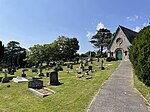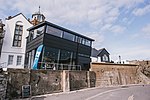Charmouth
Beaches of DorsetEngvarB from June 2016Jurassic CoastPopulated coastal places in DorsetVillages in Dorset

Charmouth is a village and civil parish in west Dorset, England. The village is situated on the mouth of the River Char, around 1+1⁄2 miles (2 km) north-east of Lyme Regis. Dorset County Council estimated that in 2013 the population of the civil parish was 1,310. In the 2011 Census the population of the parish, combined with the small parish of Catherston Leweston to the north, was 1,352.
Excerpt from the Wikipedia article Charmouth (License: CC BY-SA 3.0, Authors, Images).Charmouth
Orchard Close,
Geographical coordinates (GPS) Address Nearby Places Show on map
Geographical coordinates (GPS)
| Latitude | Longitude |
|---|---|
| N 50.7368 ° | E -2.9026 ° |
Address
Orchard Close
Orchard Close
DT6 6RS , Charmouth
England, United Kingdom
Open on Google Maps











